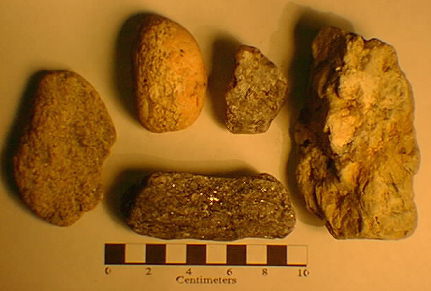
Gneiss and Granite most likely derived from metamorphic and igneous terrane of the Highlands region. Some samples display large "pegmatite" crystals. Long Island beaches sometimes yield beautiful pieces of anorthosite from the Adirondak region.
Anyone interested in seeing what kinds of rocks are common in the
New York City region needs only to go for a walk on the beach.
Look at the wave-polished gravels that accumulate in patches
around groins or on the storm deposits in the highest tidal area.
Rocks from every "geologic province" in the greater New York
Bight can be found mixed together, although in varying relative
abundance. In general, gravel seems to accumulate on the beach
in greatest abundance during the rising high tide cycles when
wave energy is relatively low.
Gravels on three area beaches were examined: Breezy Point (Gateway NRA, Rockaway, Queens, NY), South Beach (Staten Island, NY), and Sandy Hook (Gateway NRA, NJ). Sandy Hook Beach displays the greatest abundance of gravel, followed by Staten Island, then Rockaway Beach. Quartz pebbles (igneous and metamorphic origin) dominate on all three beaches, but are exceedingly abundant on Sandy Hook. The quartz pebbles on Sandy Hook were probably derived from reworked Cretaceous and Tertiary coastal plain sediments. This is also true for the abundant bioturbated, glauconitic sandstone and fossiliferous concretion materials as well.
Newark Basin-derived materials are most abundant on South Beach (Staten Island), but are also common on both Sandy Hook and Rockaway beaches.
Breezy Point's shoreline contains the least amount of gravel of the three beaches. Sand on Breezy Point is generally more fine-grained than the other beaches. Fragments of well-worn concretion material and bioturbated glauconitic sandstone similar to Sandy Hook sediments can be found on Breezy Point, suggesting that these materials were probably derived from the same source areas offshore Sandy Hook. These materials were probably transported shoreward onto Breezy Point during the late Pleistocene transgression. These materials managed to escape the grinding action of wave energy by remaining buried in the sediment for long periods of time.
Scattered "fresh" fragments of granite, schist, gneiss, and other rock-types (bearing rough or slightly worn edges) appear mixed in the sand on Breezy Point. These materials were probably derived from reworked glacial till. The other possiblility, like every rock fragment or object on the beach, is that it was dumped there by humans intentionally or accidentally!
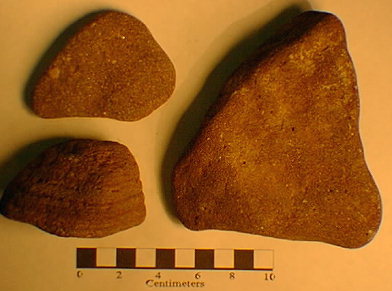

Gneiss and Granite most likely derived from metamorphic
and igneous terrane of the Highlands region. Some samples display
large "pegmatite" crystals. Long Island beaches sometimes yield
beautiful pieces of anorthosite from the Adirondak region.
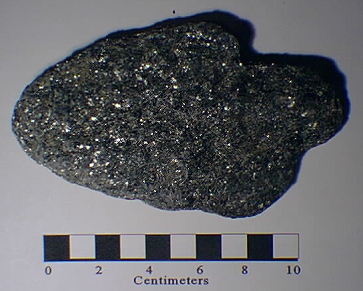
Schist likely derived from metamorphic and
igneous terrane of the Highlands region, probably from Manhattan.
Schist samples commonly display garnet crystals.
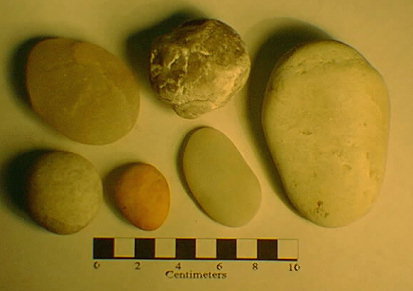
Quartz pebbles "from everywhere." Quartz pebbles were
ultimately derived from igneous and metamorphic terranes
throughout the Appalachian region. Gravel consisting dominantly
of quartz pebbles is abundant in coastal plain sediments and in
Paleozoic conglomerates in the Catskills region. Quartz pebbles
are extremely durable on the surface environment and can survive
transport over great distances and for long periods of time.
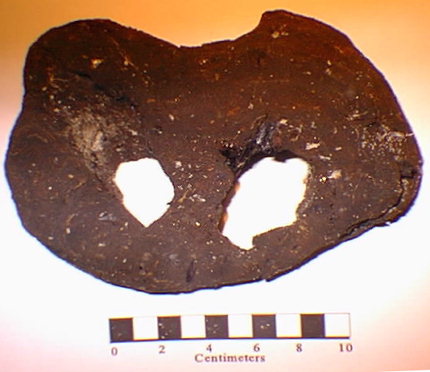
Peat is abundant in areas where nearshore subaerial
erosion has exposed older tidal flat and swamp deposits. These
materials range in age from Cretaceous (Magothy and Raritan
formations under Long Island) to early Holocene sediments. Old
peat deposits can become well indurated (lignite). Some peat beds
display orange-colored "clinker" (partially burned peat ignited
by lightning strikes in the geologic past). Some samples contain
shell fossils. This example from Westhampton Beach, NY shows
boring by clams.
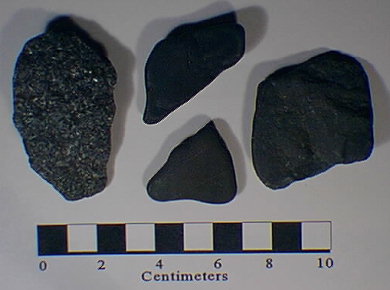
Basalt and diabase derived from Newark and Connecticut
Basin volcanic sources (Triassic and Jurassic). Some samples
display crystals of amphibole, pyroxene, and olivene. Dark green
samples with fiberous minerals are probably serpentine from
Staten Island (early Paleozoic).
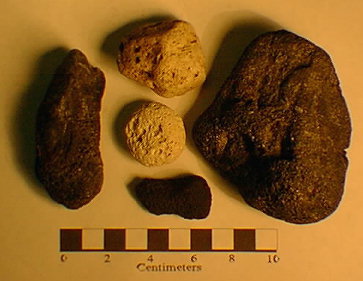
Pumice possibly derived from Caribbean volcanos and
carried northward on the Gulf Stream (along with coconuts and
other "drift-seeds," as well as and every plastic item
imaginable!). Alternatively, it came from some pipe-dream
landscaping job lost to a Nor'easter.)
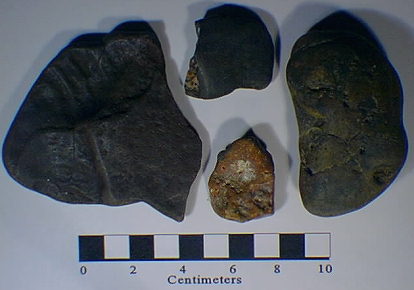
Chert derived from Paleozoic limestones and other sources
throughout the region. Check chert carefully. Chert, slate, and
argillite were used by indians for an assortment of tools and
weapons.
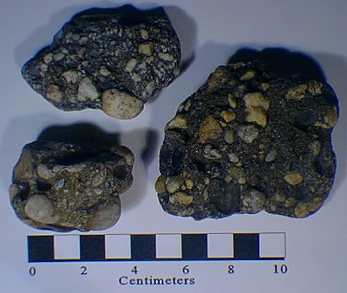
Conglomerate derived from Paleozoic metamorphic and
sedimentary formations in the Catskills and Highlands region, and
from cemented gravels in coastal plain sediments. Coastal plain
conglomerates are most abundant on Sandy Hook and tend to be
cemented with "bog iron" (limonite). Paleozoic conglomerates
tend to display evidence of metamorphic pressures. The older
conglomerate is also cemented by "red" hematite. Look closely,
however, what looks like conglomerate can be concrete.
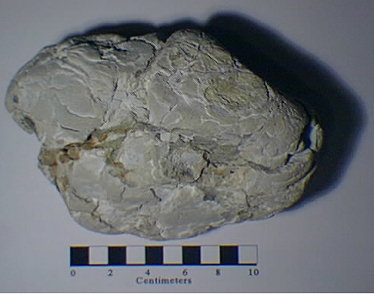
Concretion derived from Quaternary marine coastal plain
sediments. Concretions sometimes are encrusted with coral.
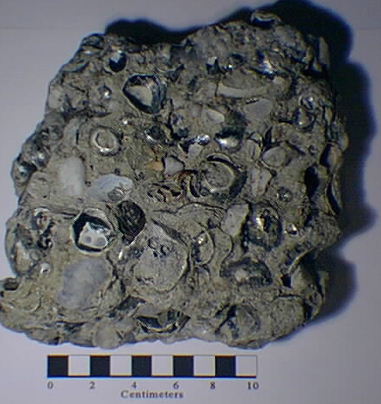
Beach rock derived from Quaternary coastal plain
sediments. Beach rock is the host material of most beach fossils.
The matrix consists of fine to coarse sand, even conglomerate.
Sand is cemented with calcite or limonite. (Shell-bearing
limonite samples may be recent "rusted iron."). This cobble of
well cemented beach rock contains jingle shells, oysters,
gastropods, shark vertebrae, and spruce pine cones.
Coal occurs naturally in abundance in pre-anthropogenic
sediments. Early reports noted "sea coal" in abundance along the
shores of Long Island long before the Industrial Revolution.
However, because of the incredible amount lost or dumped into New
York Harbor in recent historic times mosty as cellar ash waste or
ship spillage, coal is included in "anthropogenic sediments."
 Return to the
New York Bight Home Page
Return to the
New York Bight Home Page
Phil Stoffer and Paula
Messina
CUNY, Earth & Environmental Science, Ph.D. Program
Hunter College, Department of Geography
Brooklyn College, Department of Geology
In cooperation with
Gateway National Recreational Area
U.S. National Park Service
Copyright September, 1996
(All rights reserved; use as an educational resource
encouraged.)>